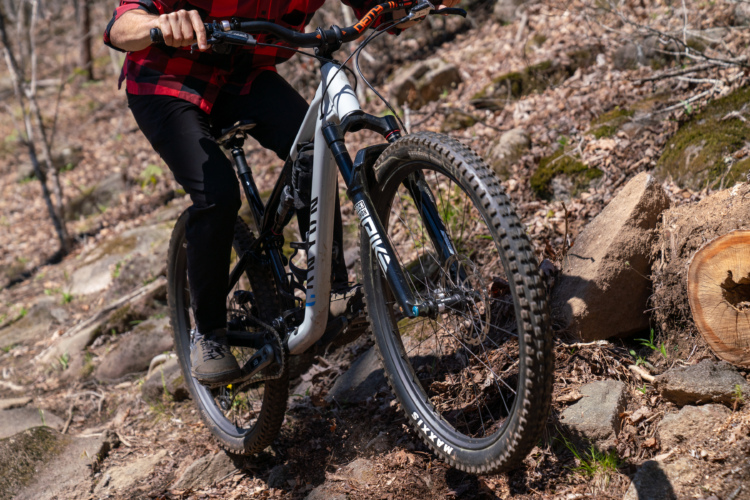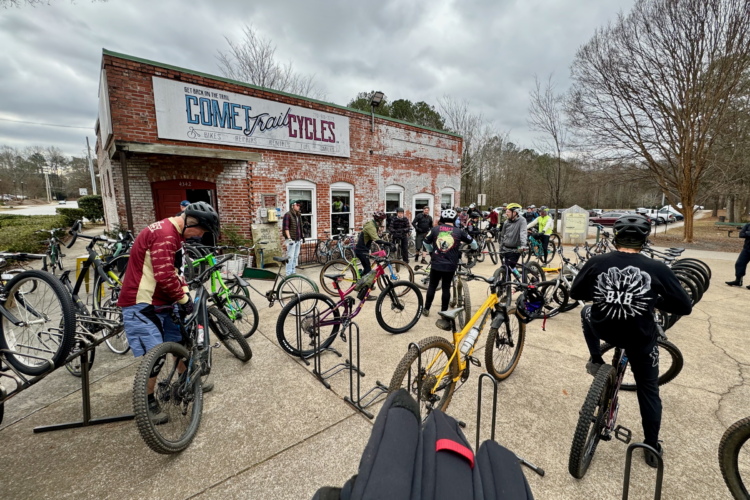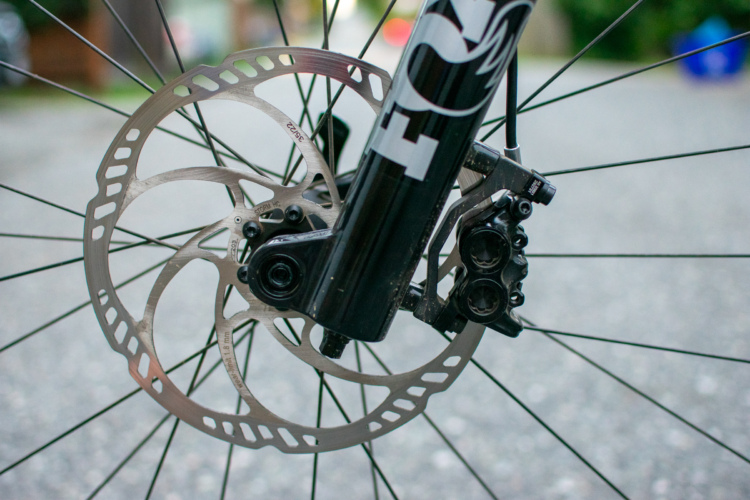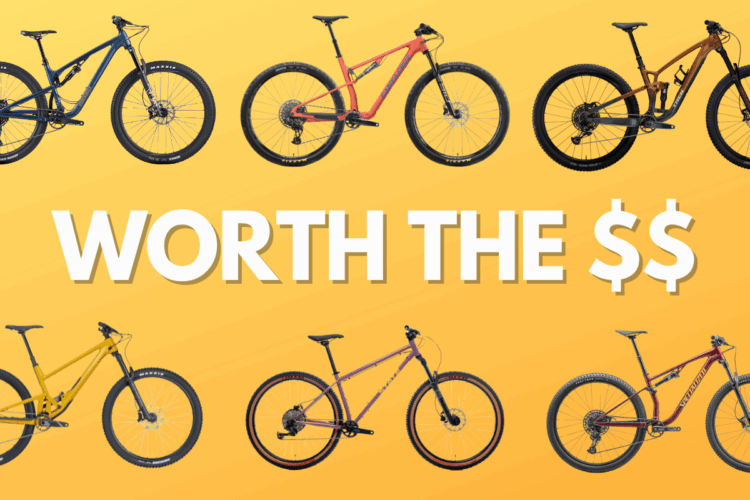
While MRP has been around for a long time and is a small mainstay brand in the bike industry, their history is still probably richer for their chain guides where they carved out a strong market. Understandably, when it comes to suspension products, like the MRP Ribbon LT coil fork I tested, this is a much bigger task up against companies like Fox and RockShox, for the same reason, smaller companies find it difficult to compete with SRAM and Shimano in the drivetrain space.
Every once in a while you’ll see an OEM-spec bike with an MRP fork, but it’s not often. Like their suspension modifications–the Ramp Control cartridge and Lift Damper, their shocks and forks are often aftermarket-thoughts.
This spring, they released three new versions of their long-running Ribbon all-mountain fork: the LT, spanning lengths from mid- to long-trail (140mm/150mm/160mm/170mm) and covering the all-mountain ground; the LT Coil, an enduro-ready fork with 150-170mm of travel and a coil spring instead of an air; and the Ribbon SL with 100mm/120mm/130mm lengths.
MRP Ribbon LT Coil key specs
- Travel: 150-170mm versions available
- Price: $1,249 as tested
- Buy from MRP

I’ve been testing the MRP Ribbon LT Coil with 170mm of travel since the spring. While the SL fork features the brand’s EssenTTial damper, the Ribbon LT and LT Coil forks are specced with the latest Lift damper. The Lift damper is also available as an aftermarket product which fits some RockShox and Fox forks too.
MRP says the Lift damper is made to provide a balance between low- and high-speed circuits, and due to a revised flow-path optimization and needle shaping, the fork is said to perform more quietly, more sensitively, and more smoothly.
The MRP Ribbon LT Coil utilizes a coil-sprung internal floating piston, even in the air-sprung fork, which should give better off-the-top sensitivity. The internals are made in-house in Grand Junction, Colorado
MRP pursued longer maintenance intervals with the new fork and those are spaced out to a respectable 200 hours. Plus, they say servicing doesn’t require any specialty tools, making it easier for home mechanics. Lower leg or “bath oil” replacements are still recommended at 50 hours. Most Fox and RockShox forks recommend 50-hour lower leg services but also recommend a damper and spring service at 200 hours.


The Ribbon LT Coil and LT forks use a 35mm stanchion. The fork features a 12-position low-speed compression adjustment, 30-position Ramp Control for bottom out support, and a 12-position rebound dial. It comes in two offsets: 41 or 46mm and is made for 29-inch wheels only.
My 41mm offset, 170mm Ribbon LT Coil fork weighs 2,250g, or 4.96lbs. Compared to the Fox 38 air fork with Vorsprung Secus I previously had on the same bike, I shaved over a half-pound with the MRP, or 320g.
On the trail
Installation was straightforward as most fork installations are. MRP offers Shredkote, a cerakote paint option for custom colors, and you can even get a different colored crown and lowers, though the stanchions remain black. There is a price: $50 to paint the crown, $100 to paint the lowers and if you want their Ready to Shred add-on, where MRP cuts the steerer tube to your desired length, installs the star nut and crown race, equips a brake adapter for rotors larger than 180mm, and sets the tune for you, it’s an extra $50. Really, it’s a good price if you want something you can throw on as soon as it hits your doorstep, but not necessary if you’re comfortable with some basic mechanical jobs and have a few spare parts lying around. If you want all the add-ons, that will bring the grand total to $1,449.
I am riding at about 170-180lbs with gear and was notified I’d be in between the yellow spring (140-180lbs) and the green spring (170-210lbs). I opted for the lighter spring at first and cranked up my low speed compression (LSC) early on, only to find that the yellow spring was plenty supportive for me, and since then I have mostly backed the LSC off, though I still adjust it as needed.
If you understand how to dial in a fork for your terrain and preference, the Ribbon LT Coil is very straightforward to configure. There is enough variation in the LSC to find the sweet spot for traction, sensitivity and support without having an overwhelming amount of clicks to sort through. The same goes for rebound as it has the same range of 12.
Ramp Control, however, might take some time with 30-clicks of play, and a little bit goes a long way. This is where you’ll find bottom-out support since the fork does not have a setting for high-speed compression. It’s still convenient to be able to set this on the fly, rather than having to find the right number of volume spacers.
My settings for the fork have settled around, give or take:
- LSC: 3-6 from fully open, depending on terrain
- Rebound: 6 from fully closed/open
- Ramp control: 5 from fully open
There’s a lot to like about the MRP Ribbon LT Coil. It has the off-the-top sensitivity and support throughout the entire stroke one can expect from a coil fork. It feels active and supportive in almost every scenario, whether you’re carrying speed around a berm, landing from a tall drop, or blasting through chunk. The new Lift damper maintains its support, ride height, composure, and responsiveness in a variety of conditions.

When I tested the MRP Raven a few years ago, I thought it was a great all-around trail fork, but a number of consumers and some media had issues with the EssenTTial damper’s performance through faster, rougher terrain. It was something I didn’t notice on the Raven then, but I have been paying close attention to the Lift damper’s performance. I’m happy to say that it’s performed admirably in the faster, chunkier trails on the Colorado Front Range.
I haven’t had issues with creaking from the steerer tube and it’s been a nice, quiet fork through its travel. Coming from a Fox 38, I wouldn’t say there is a big difference in stiffness, at least not so much that would reach a 170lb rider like me. I guess I’d call the 38 “more than enough” while the Ribbon’s stiffness is plenty at 170mm of travel. Plus, there is the added bonus of shaving more than a half-pound off the front end if you happen to come from a bigger fork like I did.
If I was going to fault the Ribbon LT Coil for one thing, it does feel like there is more stiction than some of the other forks I happen to have in my garage at the moment: an air-sprung DVO Sapphire, Fox 36 Grip2 and a RockShox Pike Select+. It’s not nearly enough to call this a deal breaker if you’re considering the Ribbon and the supportiveness and traction overwhelm the stiction, but it’s not the most buttery fork I’ve ridden.

Issues
Unfortunately, there is one more issue I have to cover on the Ribbon LT Coil. About halfway through my testing period of 4-5 months, the fork developed a nasty habit and sound. When I was coming off of drops, or bump jumps, or plain ol’ jumps, the fork started to decompress and extend so rapidly into a “kerthunk!!” at full extension, it was concerning. At first it was only once per ride, and then it happened more frequently, as if the damper was slowly disappearing.
I reached out to MRP, told them about the issue and they sent me a shipping label so I could send it in for examination.
“I’m going to say a word I hate saying…your damper had a preproduction seal head that was tighter than our production spec. This caused premature wearing of the damper rod and a loss of damping fluid – which resulted in a loss of damping,” MRP’s VP of brand Noah Sears told me.
“We’re confident no consumer has a fork with this preproduction-spec part, so your experience should be unique. But, if any consumer had an issue, we’d handle it the same way. Any defects, damper, or air-spring issues are totally covered for one year. Plus, we recently introduced a 30-day Love It Guarantee which allows customers to return a fork, shock, or suspension upgrade (Ramp Control or Lift Damper) within 30 days if they simply don’t love it.”
MRP swapped the damper to production-spec and rebuilt the fork and sent it back to me. I’ve done my best to ride it as hard as possible since then, and it’s back to performing just how it should.
This is an embarrassing thing for MRP, though this happens more than you might think in the bike (or auto) industry, as brands are eager to start building hype and awareness for new products at launch, sometimes before all production-level parts are available.
I’ll be the first to drop a comment in this article if the issue comes back, or feel free to reach out if it’s been a while, but I’m happy the Ribbon is back in action because I do really appreciate how the fork rides.

Who is this fork for?
The MRP Ribbon LT Coil fork is one of just a few choices for riders who want an off-the-shelf, coil fork for a long-travel/enduro bike. Fox 36s and RockShox Lyriks typically require a coil conversion kit, and DVO does not have a coil fork for sale. There are some long-travel coil forks out there like Marzocchi’s Bomber Z1 coil, if you can find one, or the Öhlins RFX36 M.2. I tested the Öhlins fork four years ago, and it is the same price as the MRP, but more complicated to tune and likely more complicated to service, if you’re in the US.
Maintaining an MRP suspension product does take some more commitment too, as most bike shops do not service the forks. Depending on your region you might find one or two. It’s slim even in the Denver metro area, but there are some specialty suspension shops that do take care of them. You can always ship it directly to MRP and the service prices are competitive.
Share your MRP Ribbon LT Coil review
Pros and cons of MRP Ribbon LT Coil
Pros
- Supportive through entire stroke and variety of terrain
- Easy to tune
- Great factory coil fork option in limited field
Cons
- Noticeable stiction/not the most sensitive
- Hard to find bike shops willing to service
- Still an expensive aftermarket fork option
Bottom line
The MRP Ribbon LT Coil is a great coil fork option for trail to enduro bikes with a nice balance between sensitivity and support. It’s easy to tune and composed in nearly all conditions.





















4 Comments
Aug 4, 2024
Aug 5, 2024
Aug 5, 2024
Regarding the stiction comment, there's two things I want to mention. Firstly, a coil fork will feel fundamentally different than a modern air fork at the top of travel. Fork makers have sort of hoodwinked people with the way super high-volume negative springs sink well into their travel with little force – it's nice in the showroom or parking lot, but on trail it amounts to giving up usable travel. Coil springs by comparison start pushing back as soon as you start to compress them. This sportier feel can be misinterpreted as stiction, but it's just characteristic of a linear (coil) spring rate vs. progressive spring rate (with a flatter start its curve). Maybe not at play here, but worth mentioning.
Secondly, there is shrink wrap on the coil spring to prevent noise and rattling. We've seen cases where that can be a source of stickiness. Sometimes it's as easy as relocating it slightly on the spring to make that go away. Some people even remove it entirely and use more grease instead. It varies slightly from fork to fork, as does peoples sensitivity to noise and stiction.
Cheers!
Aug 6, 2024